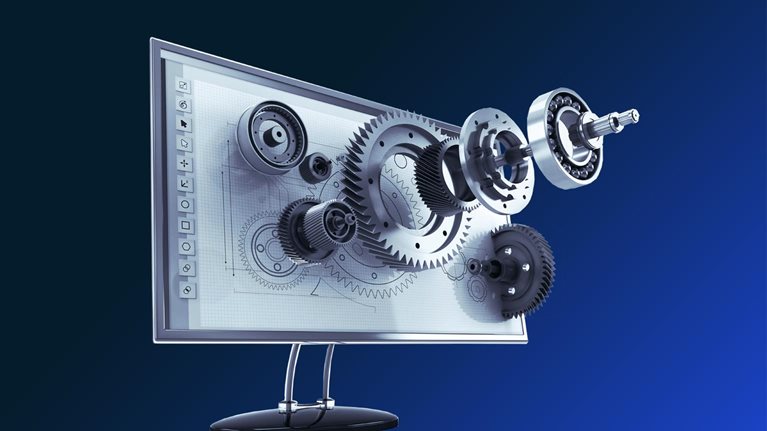Companies live or die by their ability to develop and launch new products. Over the next five years, we estimate that about $30 trillion in corporate revenues will depend upon products that have not yet reached the market.
Yet creating successful new products is getting harder to do. To give customers a compelling reason to purchase, products increasingly need performance improvements and features that require the integration of complex and novel technologies. More consumers also expect next-generation products to be more sustainable, creating new constraints around material and component selection, repairability, and end-of-life considerations. And the pressure to keep R&D costs low is as relentless as ever.
Against this background, companies are seeking to improve their digital-product-development capabilities, seeing these technologies as a way to speed up design and engineering cycles while cutting costs through R&D process optimization. In one survey, 75 percent of product development executives said that further digitization was a key priority for them.1
Digital-product-development approaches are evolving rapidly too, building on advances in computing power, analytics approaches, and artificial intelligence. These have led to the emergence of digital twins: digital replicas of current or future products that can simulate all the characteristics of their physical counterparts. Interacting with or modifying a product in a virtual space can be quicker, easier, and safer than doing so in the real world.
Product development leaders expect digital twins to accelerate product development processes and improve outcomes, all while reducing costs. They are rushing to invest in the concept, with the global market for digital-twin technologies forecast to grow at about 60 percent annually over the next five years, reaching $73.5 billion by 2027.2
In this article, we will look at the way digital twins are being used in industry today, examine the factors that underpin a successful digital-twin strategy, and discuss the future evolution of this impactful technology.
A digital twin defined
A digital twin is a virtual replica of a system’s behavior in its operating environment. That system, which might be a product, a manufacturing process, or even an entire supply chain, is represented by a collection of digital models. Those models process and react to various stimuli, which are data representing the external environment. Digital twins combine multiple types of models and process data from multiple sources. That allows them to offer a better approximation of a real object than traditional simulation approaches.
In this article, we will focus on product digital twins. These can be characterized by three key dimensions: the level of modeling and data sophistication employed, the physical scope of the twin, and the parts of the value chain it encompasses (table).
Table. Digital twins can operate at increasing levels of value-chain inclusion, scope, and sophistication.
| Value chain | Engineering: ranging from product definition to validation and release for manufacturing | Production: encompassing a product, its systems, and its components | Service: including product sales through end of life and recycling | |
|---|---|---|---|---|
| Scope | Component: single, simple element within a product | System: combination of components that interact with each other to perform a specific function | Product: full product consisting of all systems and subsystems | |
| Sophistication | Data foundational: linking of data from various sources | Traditional simulation: use of simulation tools to perform analyses of design performance | Automated design refinement: use of predictive analytics and machine-learning technology to run automated simulation refinements and automatically produce optimized results | Closed-loop real-world link: use of multiple advanced simulation models that react dynamically to changing environments, regularly infused with real-world data from manufacturing and testing |
As organizations learn to build and use digital twins, they traverse each of these dimensions, starting with the simplest. The scope of an early digital twin might be a single, critical component, for example, expanding to a whole product as the company’s level of digital-twin maturity increases. Similarly, early digital twins may be applied in just one area of the value chain, often engineering, while later twins may also simulate the product in manufacturing and use.
Digital twins today
In advanced industries, survey data indicate that almost 75 percent of companies have already adopted digital-twin technologies that have achieved at least medium levels of complexity. There is significant variance between sectors, however. Players in the automotive—and aerospace and defense—industries appear to be more advanced in their use of digital twins today, while logistics, infrastructure, and energy players are more likely to be developing their first digital-twin concepts.
One major aerospace company is developing a machine-learning-based geometry optimization system that can simulate thousands of different configurations at high speed to identify weight savings, aerodynamic improvements, and other performance benefits. A European software company is building a multiphysics model of the human heart to support drug and medical-device development.
In the United States, an automotive company is building a system that can model all the software and hardware configurations it offers. The system will be used to simulate the effect of design improvements before they are delivered to customers as over-the-air updates. And a US multinational industrial company is developing multiphysics models of turbines to enable real-time wear prediction, performance fine-tuning, and the optimization of output against service life and total cost of ownership.
These companies and other digital-twin pioneers cite four main motivations for their investment in the technology.
- Digital twins provide a risk-free product development environment, allowing design and engineering teams to explore more design options without the cost associated with the production and testing of physical prototypes.
- Digital twins improve testing and validation by allowing new solutions to be evaluated in a wide range of lifelike scenarios, including unusual and extreme operating conditions.
- Digital twins provide deeper insights into product behavior. Engineers can use digital-twin models to monitor the state of any part of the system at any time and to trace complex interactions between product elements.
- Digital twins allow real-world data to inform product improvements by simulating the impact of proposed design changes using data collected from products operating the field.
Our conversations with senior R&D leaders show that digital twins are already making a significant difference for product development performance. They have cut total development times by 20 to 50 percent for some users, reducing cost along the way. For others, they have reduced the number of expensive preproduction prototypes to be built—often from two or three to just one. Because so much testing, verification, and customer-acceptance work can be completed in a virtual environment, some companies report that products starting out as digital twins have 25 percent fewer quality issues when they enter production. They have a higher chance of succeeding commercially, too: one company reported 3 to 5 percent higher sales of digital-twin-based products, thanks to better features, higher quality, and improved customer satisfaction. Finally, a digital twin created during product development can allow companies to offer a range of value-added aftermarket services, including predictive maintenance and in-service performance optimization. That can increase revenues by 5 to 10 percent in some product categories.
A new way of working
Integrating digital-twin technology into the early stages of product development could allow companies to adopt processes that work faster, deliver better results, and bring them closer to their customers. Take the design of complex, highly customized products such as machines for advanced manufacturing, for example. Such products are typically made as one-offs or in extremely small volumes, and each unit requires significant up-front engineering input. Using conventional engineering methods, the absence of prototypes means that these products often require significant work after delivery to iron out problems and optimize performance.
A company with a robust digital-twin platform, by contrast, can conduct comprehensive full-product simulations in a virtual environment before any proposed design is signed off on by the customer. Since complex machines typically use a combination of existing and newly engineered elements, companies can keep a library of digital-twin models of key components, combining them with the models of new parts to create the full digital twin. That twin can be used to demonstrate the proposed solution to the customer and verify that the new design meets their needs. And the digital-twin models of the new components can then be added to the library, making them available for future projects with similar requirements.
Adopting twins: Overcoming the challenges
Building a digital-twin platform is tricky, however. Early adopters report challenges around integrating digital-twin technologies into their existing digital-product-development environment and wider IT infrastructure, for example. Digital twins also require new ways of working, both within R&D functions and beyond them. That means a successful digital-twin program is a change management effort, requiring senior management commitment and support, and a strong program management team to track milestones, develop new processes, and support their adoption by the organization.
To overcome these potential roadblocks, companies can adopt a phased approach to digital-twin adoption. The first three phases address the technological challenges of platform selection, architecture design, and integration. Subsequent phases focus on the organizational transformation required to support new processes and working practices.
- In the competitive intelligence and scoping phase, the organization identifies the types of digital-twin solutions available in its sector and estimates the potential value offered by each type. This work, which will involve a deep dive into digital-twin applications in other companies, will also help the organization develop a framework for its own transformation journey.
- In the architecture design and software stack definition phase, the organization will identify the specific software components, relationships, and interfaces it will need to meet its digital-twin ambitions. It will design a software stack that provides the relevant capabilities, using a combination of existing digital-design tools and new elements. And it will decide whether those elements should be developed in-house or acquired from an internal provider.
- In the software-development-excellence phase, the organization will develop the processes and capabilities it needs to develop, integrate, and launch its digital-twin platform.
These three phases will require staff with a range of specialized skills, including systems engineers for requirements definition and analysts for model development. At its peak, a digital-twin platform development team may involve about 50 people.
To integrate digital-twin technology into the organization, companies can opt for one of three archetypes (exhibit). The digital-twin team could be structured as a separate business unit that is responsible for creating its own distinct portfolio of digital assets that are sold alongside the corresponding physical assets. Or the digital-twin team could be integrated into an existing business unit, with a focus on developing and supporting digital-twin applications associated with the products of that business. This approach can be a good way to gain experience with digital twins, or might be appropriate where limited synergies between business units mean there is little additional value to be gained by carving out the digital-twin team as a separate unit. Finally, the digital-twin team can operate as a separate center of excellence that supports the development of applications within existing business units. This approach helps companies scale their digital-twin efforts quickly while ensuring consistent processes and technology components.

Digital twins are helping product companies capitalize on recent advances in the Internet of Things artificial intelligence. As these technologies continue their recent rapid progress, digital twins can be expected to evolve in parallel. It is feasible that digital twins will soon be able to proactively search for new insights, for example by altering the settings of sensors and acquisition hardware installed on products in the field. They will be able to use those data to refine their own models and generate new insights for manufacturers and users. Interaction between digital twins will enable the simulation of highly complex environments, such as port operations, city transport systems, or multistakeholder engineering supply chains. Eventually, we may see the emergence of digital twins capable of learning from their own experiences, identifying opportunities and offering product improvement suggestions entirely autonomously.

